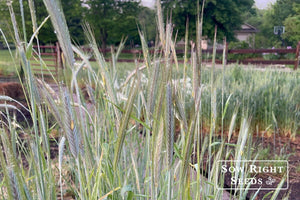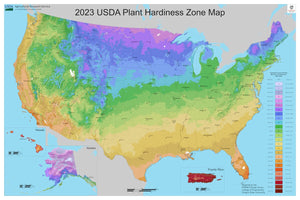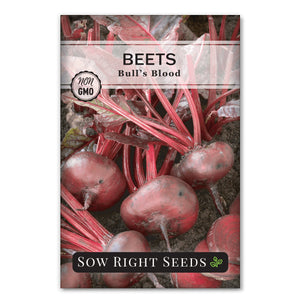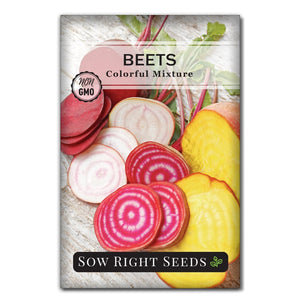Better Soil for Better Beets: The right way to grow beets from seed
BeetsBeets are easy-to-grow root vegetables that can be grown all over the world. Beets started as a forage crop for animals, but eventually, humans caught on to the delicious, colorful roots hiding beneath the surface.
Now we know that beets are healthy for our whole body, from our bones to our heart. With our simple tips on preparing the soil to grow beets from seed, you can easily add this healthy crop to your vegetable garden.

How to Grow Beets From Seed
Our Sow Right Seeds beet planting guide will cover the beet growing basics:
Preparing the soil for beets
Sowing beet seeds
Watering, weeding, and thinning beets
Harvesting beets
Heirloom beet varieties
Preparing the soil for planting beets
Beets can grow in all kinds of soil, but if you want tender, delicious, well-shaped beets, start with your dirt.
Make sure you have nutrient-rich soil that can hold moisture but also drains well. If the soil dries out too quickly, it is hard for the beets to get the water they need. If they get waterlogged, they will rot.
Remove any rocks or large debris, as these can cause misshapen roots.
Prepare your garden soil by first checking the nutrients and the pH. Beets prefer neutral to slightly acidic soil. If the pH is below 6, then you will want to add limestone or wood ashes. Soil rich in phosphorus will grow the best beets. And too much nitrogen will make beets fork and be “hairy.”
Also, test the soil to make sure there is enough boron available. You can add boron if the soil is alkaline.
Add fertilizer and make any necessary adjustments to the soil before planting beets.
With this planning up front, you won’t have to do any other fussing over your beets. They’ll quickly grow and give you a tasty harvest in around nine weeks.
Sowing beet seeds
Once your garden soil is ready, it’s time to sow your beet seeds.
Beet seeds can be planted in early spring to mid-summer when the soil temperature is 60º to 70º F.
Each beet seed is actually a dried-up fruit. Inside, it has 2 to 6 individual seeds.
For better germination, you can soak beet seeds for 24 hours before planting.
Plant beet seeds directly outside in deep, fertile, evenly moist soil.
Sow seeds 1/2” deep and 2 to 4 inches apart.
Beet seeds will germinate in 5 to 15 days depending on soil temperature and moisture.
Beets can also be started in a cold frame or indoors 5-6 weeks before the last spring frost. When starting beets indoors, you need to be careful when transplanting the seedlings outdoors. Try soil blocking or peat pots that can tear away so you don’t disturb the vital taproot when transplanting.
Plant beets in full sun.
Sow beet seeds every 2 to 3 weeks for a continuous harvest.
For a fall crop of beets, plant seeds about 7 weeks before the first fall frost, followed by another planting around 3 weeks later. This should give you two harvests of beets before the ground gets too cold for germination.
Watering, weeding, and thinning beets
Beets are a hardy vegetable and relatively disease free.
Consistent watering is essential for beets, as the roots can split in drought conditions.
Start with a weed-free bed, and the beet greens can shade out any weeds that try to grow later. But if weeds do sprout, pick them quickly before they have a chance to grow and compete with the beets.
Thin seedlings before they get too large. Beets need space for proper root development. If they are crowded, they won’t develop a nice round shape.
You can start thinning beets as soon as two true leaves develop. Thin the beets so that they are about 4 inches apart. Cut the tops off at the soil level to thin rather than pulling them out to avoid disturbing the other beet roots.
As the beets grow, you don’t need to add additional fertilizer as long as sufficient phosphorus and potassium are in the soil. Too much nitrogen will result in nice leaves but small roots. (Which some gardeners may wish to do.)
Most varieties of beets require 60 days to reach maturity.

Harvesting beets
Beet leaves can be eaten like chard and other greens. The first harvest of beets can be the early beet greens. Pick only a few leaves from each beet so that the roots still have enough leaves for photosynthesis as they grow. When you harvest the roots, then you can eat all the greens.
Beets can be pulled up starting when they are small, around 2 inches. Most varieties can get woody in the hot summer months if they are left too long in the soil. Beets around 2 to 4 inches are usually a good size for flavor and tenderness.
To harvest beets, lift them out of the soil and brush off the dirt.
You can twist or cut off the tops, but leave about one inch of the top. If you cut into the beet, it will bleed the color.
Store beets in a cool, dry location.
You can store beets in the fridge with the tops on. However, the tops won't stay fresh as long as the beets. So plan to use the greens within a few days.
In cool weather, beets can be left in the ground, and after a light frost, they will taste even sweeter.

Eating beets
Beets are healthy vegetables that are high in folate, manganese, potassium, fiber, and vitamin C.
Beets can be enjoyed in a variety of ways, such as roasted, boiled, and pickled. They can add a dash of color to salads and vegetable platters. They’re also a healthy, colorful addition to fresh juice.
Both raw and cooked, you will want to peel beets before eating them. When raw, you can peel them with a vegetable peeler. If you are going to cook them, wait until after they are cooked to peel them. This way, the color won’t bleed as much, and the skins are easy to remove.
Heirloom Beet Varieties
Colorful Mixture Beets
This colorful mixture of beets gives you a chance to try some new colors and flavors. The Colorful Mixture includes beets in beautiful shades of deep red, purple, gold, and candy-striped. Plant these beets for a fun fresh beet salad or a picturesque jar of beet pickles.
Chioggia Beet
Chioggia Beet is a lovely heirloom beet from Italy. With red stripes, the variety is also called Candy Cane or Candy Stripe. Cut one open, and you can see why!
These beets are crisp with a sweet and earthy flavor. They do not bleed as much as many other beets, so they are lovely eaten raw in vegetable platters and salads, slaws, pickled, roasted, juiced, and more. They are very nutritious and are an excellent source of vitamins, minerals, fiber, and antioxidants.
Cylindra Beet
An heirloom variety from Denmark, Cylindra Beet grows long, cylindrical roots, making it a perfect space-saving beet.
Cylindra slices beautifully, is never woody, and has exceptionally sweet greens. Whether eaten raw, roasted with goat cheese, in a salad, or pickled, the earthy goodness of beets is unmistakably delicious. This queen of root crops is so sugar-sweet it is no wonder that it is so nutritionally dense.
Detroit Dark Red Beet
These beets set the standard for red beets. Detroit Dark Red beets develop 2-3" round beets that have sweet red flesh and tasty edible greens. Detroit Dark Red can also tolerate temperature variations.
Both the leaves and the roots are amazing in salads and other dishes. The roots are sweet and delicious and are amazing when roasted or pickled. The leaves, when picked young, add delicious color and crunch to fresh salads.
Golden Globe Beet
For something a little different than the traditional color, try Golden Globe. This is a rich gold beet that does not bleed when cut or cooked. Golden Globe is exceptionally mild and sweet, without the earthy flavor of red beets.
Bull's Blood Beet
Bull's Blood Beet is a lovely cool weather plant that is known for its stunning reddish-purple leaves as well as its globe-shaped roots. Roots develop into tender 2-3" baby beets that have a delicate candy-striped interior with pink rings. 50 days to maturity.
Quick and easy way to cook beets
My favorite way to cook beets is to use an electric pressure cooker. Depending on the size, 15 to 20 minutes is all it takes. Don’t cut the tops or bottoms before boiling or pressure cooking. Scrub off all the dirt and rinse the beets with cool water. You may need to use a vegetable brush to get all the dirt off.
Place the beets on the rack in the pressure cooker. Add 1 cup of water to the pot. Turn the top vent to "pressure" and set the cooking time to 15 minutes.
After they are cooked, cool the beets in cold water and peel them. The outer skins will slide off easily when you rub them with your hands. Slice up the cooked beets to eat with salt and butter or use in recipes.
Beets are an easy vegetable for beginners and don’t require a lot of attention. With these reliable heirloom varieties from Sow Right Seeds, you can enjoy a delicious harvest of beets this year.
Written by Beverly Laudie
Found this blog helpful? Share it with your gardening friends!









Leave a comment